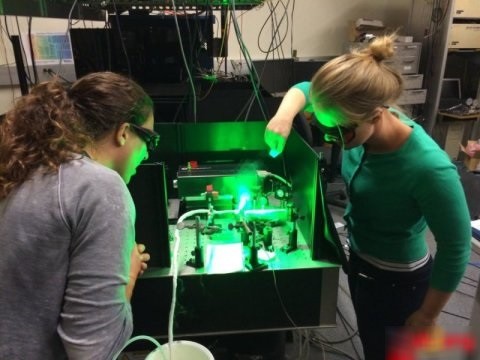Abstract Researchers at the US Department of Energy (DOE) Berkeley Labs and the University of California at Berkeley have demonstrated that diamonds may be the future of nuclear magnetic resonance (NMR) and magnetic resonance imaging (MRI)...
Researchers at the US Department of Energy (DOE) Berkeley Lab and the University of California at Berkeley have demonstrated that diamonds may be the key to future nuclear magnetic resonance (NMR) and magnetic resonance imaging (MRI) technologies. 
Alexander Pines is a senior professor of the University of Berkeley's Materials Science and Glenn T. Seaborg chemistry professorship. In his lead study, the researchers recorded the first diamond at any room temperature and crystal orientation. In situ NMR hyperpolarization of the medium carbon-13 nucleus. The hyperpolarized carbon-13 spin signal shows that the NMR/MRI signal sensitivity is enhanced over the order of magnitude that is typically possible with respect to conventional NMR/MRI magnets at room temperature. In addition, this hyperpolarization is achieved using microwaves rather than relying on precise magnetic fields for hyperpolarized transfer.
Pines is a co-author of a paper on Nature Research published in Nature Communications. The title of the paper is "Room-in-situ nucleus spin hyperpolarization at the center of the optically pumped nitrogen vacancy in diamond." Jonathan King, a member of the Pines research team, is the first author of the article.
The authors report that six percent of the somatic nuclear spin polarization is observed, which is a NMR signal enhancement that is about 170,000 times greater than the thermal equilibrium. The hyperpolarized spin signal can be detected in situ by standard NMR probes without the need to move the sample back and forth or the precise crystal orientation. The authors believe that this new hyperpolarization technique should allow for an order of magnitude increase in sensitivity to solid-state and nuclear NMR studies at room temperature.
"Our results represent a NMR signal enhancement comparable to that obtained by Lucio Frydman of the Weizmann Institute of Science and colleagues in their groundbreaking experiments, but by microwave-induced dynamic nuclear hyperpolarization in diamonds, Precise control of the magnetic field and crystal orientation is required," says Pines. "The possibility of room temperature hyperpolarized diamond turning on NMR/MRI polarization from an inert, non-toxic, easily separable source to any sample is contemporary NMR/MRI technology. A goal that has been pursued for a long time."
The combination of chemical specificity and non-destructive properties makes NMR/MRI technology an indispensable technology in a wide range of fields including chemistry, materials, biology and medicine. However, its sensitivity issue remains a persistent challenge. The NMR/MRI signal is an intrinsic quantum property called electrons and nucleus called "spin". The electrons and nuclei can be assigned an "up" or "down" direction like a rotating small magnet bar. The NMR/MRI signal depends on the majority of the nuclear spins that are polarized in one direction—that is, the higher the degree of polarization, the stronger the signal. After decades of efforts, Pines and his team have developed a number of methods to hyperpolarize the spin of the nucleus. For the past two years they have focused on diamond crystals and an impurity called the nitrogen vacancy (NV) center where optical and spin free are coupled together in the center of the nitrogen vacancy.
"When two adjacent carbon atoms in the crystal lattice of a pure diamond crystal are removed from the crystal lattice, leaving two voids, one of which is filled with one nitrogen atom and the other remains vacant, a nitrogen vacancy is obtained. (NV) Center," explains Pines. This causes unbound electrons to appear between the nitrogen atom and the vacancies, producing a unique and well-defined electron spin polarization state. “In previous studies, Pines and his team found that low-intensity magnetic fields can be used to transfer NV-center electron spin polarization to nearby carbon-13 nuclei, resulting in hyperpolarized nuclei. This is called dynamic nuclei. Polarized spin transfer processes have previously been used to enhance nuclear magnetic resonance signals, but are always performed under high-intensity magnetic fields and low temperatures. Pines and his team eliminated these requirements by placing a permanent magnet next to the diamond.
In our new study, we use microwaves instead of magnetic fields to match the energy between electrons and carbon-13 nuclei, eliminating some of the difficult limitations on magnetic field strength and alignment, making our technology easier to use," King said: "In addition, in our previous research, we indirectly inferred the existence of nuclear polarization through optical measurements, because we can not test whether the sample is globally polarized or only the core very close to the NV center is polarized. By completely eliminating the need for magnetic fields, we are now able to directly measure large samples with NMR.
In the article by Nature Communications, Pines, King and other co-authors say that hyperpolarized diamonds that can be effectively integrated into existing manufacturing technologies and create high surface area diamond devices should provide a universal basis for polarization transfer. platform.
"We hope to use existing polarization transfer techniques such as cross-polarization in solids and cross-relaxation in liquids, or direct dynamic nuclear polarization of the NV center peripheral core to obtain highly enhanced nuclear magnetics of liquids and solids. Resonance," King said, should note that this shift to solid surface and liquid polarization transfer has been demonstrated by the Pines research team using laser-polarized Xe-129. "Our hyperpolarization technology based on optically polarized NV centers is more powerful and efficient and should be applied to any target molecule, including biological systems that must be kept close to room temperature."
Diamond Electroplated Grinding Wheel
DIY,special
Guanghan Longrun Science and Trade Technology Trade Co., Ltd. , https://www.kairungongju.com
